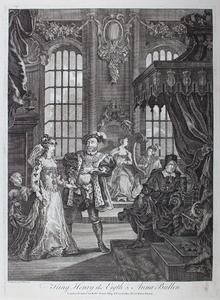| Method | Copper engraving |
| Artist | after William Hogarth |
| Published | Designed by Wm. Hogarth. London, Printed for Robt. Sayer, Map & Printseller, No 53 Fleet Street. [Robert Sayer. London, 1767] |
| Dimensions | Image 335 x 250 mm, Plate 360 x 265 mm, Sheet 450 x 285 mm |
| Notes |
A reduced engraving after Hogarth's Henry the Eighth and Anne Boleyn, from Robert Sayer's Les Satyres de Guillaume Hogarth Oeuvre Moral et Comique. Sayer published Les Satyres under the auspices of Jane Hogarth, who had been granted copyright over her late husband's works by Act of Parliament. Although Sayer, alongside the Bowles', Wilkinson, and Philip Overton, issued full size examples from Hogarth's plate separately and with various combinations of verse below, this smaller plate seems to have been engraved specifically for his Les Satyres. Hogarth's engraving of Henry the Eighth and Anne Boleyn was issued to capitalize on the attention given to the fabulously successful staging of Colley Cibber's production of Shakespeare's Henry VIII at Drury Lane in 1728. It is unclear if the engraving was based upon an earlier painting, or whether paintings after the engraving appeared as a result of its success, though the print's engraving certainly suggests an attempt to capture the manner and tones of a composition in oil. The scene itself is of Hogarth's own making, rather than drawing directly from Shakespeare, and while Henry is based on Holbein, the other figures may draw upon the portraits of the actors themselves, particularly Cibber as Wolsey to the right. To left of centre, the King takes the hand of Anne Boleyn. Queen Catherine and Lord Percy, Anne's first lover, look on in frustration, while Wolsey leans heavily upon the arm of the throne, in an attitude of concern over this new romantic development. The first state of Hogarth's plate featured a lengthy poem below, with seven couplets divided into three panels below the scene, describing the three main figural groups: Henry and Anne, Catherine and Percy, and Wolsey. William Hogarth (1697 - 1764) was born in London, the son of an unsuccessful schoolmaster and writer from Westmoreland. After apprenticeship to a goldsmith, he began to produce his own engraved designs in about 1710. He later took up oil painting, starting with small portrait groups called conversation pieces. He went on to create a series of paintings satirising contemporary customs, but based on earlier Italian prints, of which the first was The Harlot's Progress (1731), and perhaps the most famous The Rake's Progress. His engravings were so plagiarised that he lobbied for the Copyright Act of 1735, commonly referred to as 'Hogarth's Act,' as a protection for writers and artists. During the 1730s Hogarth also developed into an original painter of life-sized portraits, and created the first of several history paintings in the grand manner. Robert Sayer (1725-1794) was one of the most prolific and successful British publishers, cartographers, and print-sellers of the Georgian era. Following his brother's marriage to the daughter in law of the publisher John Overton, Sayer continued the business, branching out into sea charts, maritime atlases, and general maps. In addition to his cartographic achievements, Sayer was also instrumental in growing the public taste for prints after paintings, particularly those by Johan Zoffany, with whom he developed a lifelong friendship as well as a lucrative business partnership. Following his death, the business was continued by Laurie and Whittle. Condition: Excellent impression. Minor time toning and surface dirt to edges of sheet, not affecting plate. |
| Framing | unmounted |
| Price | £75.00 |
| Stock ID | 50696 |

